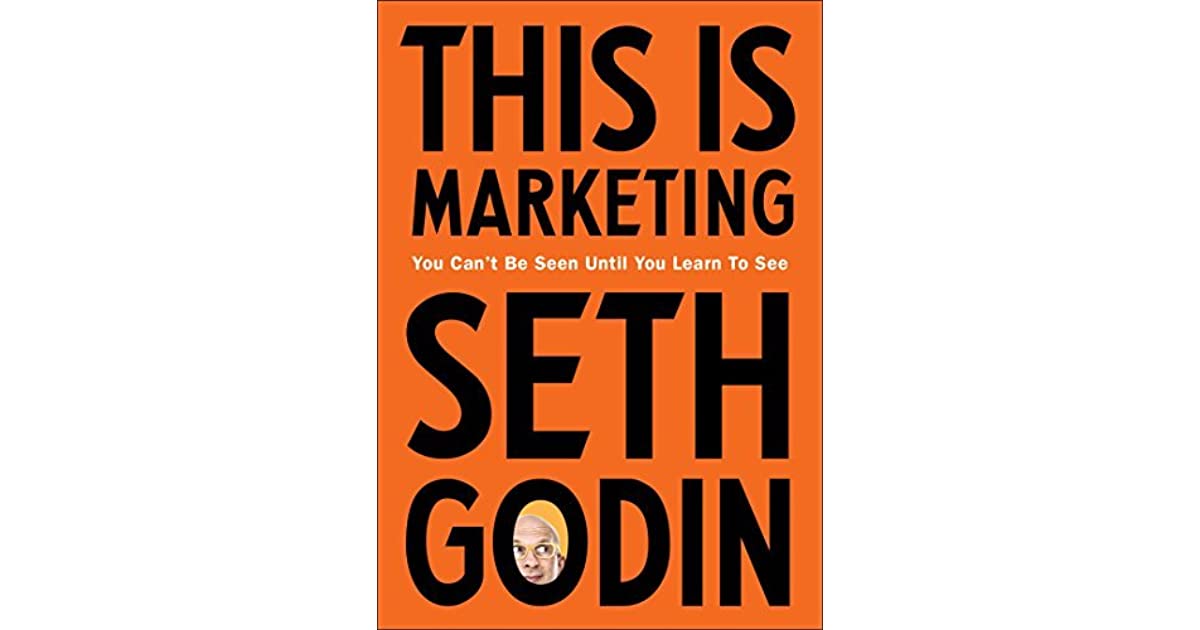Godin, Seth. This Is Marketing: Making & Sharing Work That Matters. PORTFOLIO PENGUIN, 2018.
I’m a college professor who teaches English, and I have a marketing problem. Our university’s English majors are disappearing, and I’m worried about our university cutting our program. I teach three general education courses a semester, but my passion for my subject area isn’t translating into many converts. Our faculty and student community is solid but not as robust as I wish it were. In short, I have an enrollment problem, which is exactly the problem Seth Godin says marketing was designed to solve. I might think the problem is spreading the word: “If only more people knew!” Godin says that this confuses marketing with advertising. The problem of audience, design, and storytelling all must come first. Marketing is about making change and, if done well, produces a virtuous cycle where I get to help people who want to change themselves or the world do the work they want to do. It’s as simple, and difficult, as that.
Here’s another way of thinking about my problem: the world is filled with locks, and I make a particular key. Good marketers find locks that need a key and produce one. Bad marketers make a key then run around hoping to find a lock it will fit. This is the problem of curriculum. Godin argues that the question of audience is fundamental to good marketing. I can’t start making a product without thinking about who that product is for. I have to know the beliefs and desires of the people who I seek to change. This is not to say that my freshmen know what should be in our curriculum. The horse and buggy traveler didn’t know they wanted a car, but they probably knew they had a transportation problem. The car was a compelling answer. If I create courses without my students’ beliefs and desires in mind, I will fail.
Godin (implicitly) supports the work I’m doing, as he encourages marketers to think of those they serve as “students” rather than “clients” or “customers.” Good marketers want to teach and seek students who want to learn. We should focus on our smallest viable audience. Another way of saying this is the change we’re seeking to make is not for everybody. Even if you seek to have the world transformed by the good news of Jesus Christ, you yourself are incapable of making that change happen for everyone. You begin, then, by figuring out how many people you could help so that your marketing mission is sustainable. I don’t need English to be the biggest major on campus. We need to have enough students so that our upper division courses won’t get cancelled. Next, we should produce tension. (I realize that Godin has purposefully changed the common business lingo “point of pain” to something that emphasizes pressure but not torture). The marketer not only highlights that tension, but intensifies it as a call to action. Finally, the best marketers design products that work best when they encourage others to share the story or demand a community. The fax machine or Facebook only work when other people use them too.
Marketers are storytellers who create storytellers. The story that comes with our product will help those we seek to serve share our story. The key marketing story is often positioning: your unique service proposition. Godin says this approach does not necessarily work for our post-mass advertising world. Not only does it come to the problem with a solution built on scarcity but it also assumes that the goal for your product is a huge audience. You are better off, Godin argues, creating an X / Y graph with extremes marking each pole and then figuring out which coordinates best fit your product and the kind of change you want to make. I could see the X coordinates for our major emphasizing reading OR writing and Y coordinates for our major emphasizing analysis OR creativity. Suppose we chose reading and analysis. We would give our students the canonical works and invite them to leave school with a sense of the best literature in the Western Tradition. On the other hand, if we emphasized reading and creativity, the curriculum in each course would be a product of student interest and anything but standard. Think of a course that read a book from five different sections at the Barnes and Noble. Yes, a novel. But also a business book and a cultural studies book and a biography and a devotional. You could imagine different points of emphasis by substituting writing for reading. The point is that we need to tell a better story about our major: “this major is for readers” or “this major is for writers” is how that story might begin.
Now we can talk about advertising, the act of spreading the word. Godin divides advertising in two: direct and brand. His advice is simple. If your advertising is direct and designed to get a sale, you must crunch the data on absolutely everything connected with it. If your advertising is about branding and the image and larger story of your product, then you must plan to be patient. Brand marketing is highly effective, but it takes time. The biggest problem, of course, is confusing the two. An event like a literary festival is brand marketing. Course advertisements are direct.
Finally, anything worth marketing is worth doing for the long haul. Godin’s keywords here are trust and permission. Because we’re committed to making a longterm change, we should seek to build trust with those we seek to serve. That means, we should seek a group of likeminded individuals who want to hear from us. Mass advertising is spam. Here’s how you know if you’ve built a community worth serving: when no one hears from you for three months, you hear from the community asking if everything is all right. You’re missed! One of the best things I can hear from a former student is, “I think about that English class all the time. I keep running into things I learned in that class that help me now.”
Godin wrote the book as a companion to his online marketing course. I was a student in the course, and the book does an excellent job of distilling his teaching sessions into readable prose. Godin has posted a blog every single day for over ten years, so if you’ve encountered his writing you know what you’re going to find. There are over twenty chapters here, and they’re each broken up into blog-post sized sections with case studies, charts, and memorable images. I think Godin is the best combination of practitioner and self-help motivator out there. As a companion to any project worth doing, This Is Marketing is an indispensable book I will keep coming back to, even if the change I seek to make has nothing to do with majoring in English.

